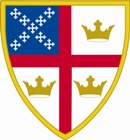All Saints' history started in 1884 in the Episcopal Church in Florida (1838). Here is a brief story of the growth of our parish and the Diocese of Central Florida.
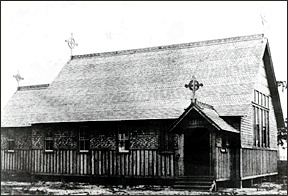 In 1884, the first railroad line connecting the Florida coasts opened up new opportunities for citrus development. A group of English settlers founded the town of Acton between Lake Parker and Lake Bonny and built an Episcopal church, which they called "All Saints" on what is today East Gary Road. The small community failed and dispersed after the freeze of 1890 ruined its economy and the
In 1884, the first railroad line connecting the Florida coasts opened up new opportunities for citrus development. A group of English settlers founded the town of Acton between Lake Parker and Lake Bonny and built an Episcopal church, which they called "All Saints" on what is today East Gary Road. The small community failed and dispersed after the freeze of 1890 ruined its economy and the 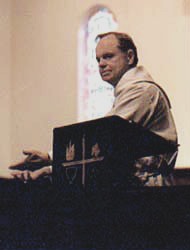 little church was closed for three years. However, after serving there on a monthly basis for five years before the freeze closed the church, the Rev. John H. Weddell, who was serving in Thonotosassa, was unwilling to see the mission die. He obtained permission from Bishop Weed in 1892 to move the little building to the corner of Lemon and Massachusetts Avenues in nearby Lakeland.
little church was closed for three years. However, after serving there on a monthly basis for five years before the freeze closed the church, the Rev. John H. Weddell, who was serving in Thonotosassa, was unwilling to see the mission die. He obtained permission from Bishop Weed in 1892 to move the little building to the corner of Lemon and Massachusetts Avenues in nearby Lakeland.
The Rev. Weddell moved to Lakeland in 1892 and the tiny Episcopal community began to grow. When he retired in 1914, he had served a total of 27 years as vicar. The 1991 Annex was named in honor of his long service.
On his retirement, the mission was designated as a self-supporting parish, the Rev. Richard Bolton was named rector, and a rectory was built behind the church. The Rev. John B. Curtis who oversaw construction of an education building to accommodate the growing number of programs serving the church and community succeeded Rev. Bolton in 1916. When the Rev. Curtis retired in 1922, the membership stood at over 200, and issues of space had become paramount. The new rector, the Rev. G. Irvine Hiller, led the parish in choosing to build, instead of a new parish hall, a new church. Thus, the wooden church, which had served since Acton days, was demolished. Its furnishings, including the altar carved by the Rev. Weddell, were incorporated into the St. Mary's Chapel of the new Spanish Revival building, which could accommodate 400 at worship.
This construction came none too soon as Lakeland flourished in the Land Boom of the 20's. The parish increased to 900 members by 1930 when the Rev. William F. Moses was called to succeed the Rev. Hiller. Despite the Depression, the mortgage was paid off, and the church interior was decorated, including stained-glass windows in the nave. The wooden education building was sold and classrooms were built in the undercroft. Space was then set aside for a nursery and parlor. Many activities for young families were initiated during this time. The Rt. Rev. John M. Allin, 23rd Presiding Bishop of the Episcopal Church, visited All Saints', Lakeland, on February 26, 1984.
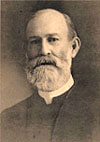
The Rev. Moses served until 1953. These were years when it became evident that Lakeland held great growth potential and that the Episcopalian community was growing beyond what one location could accommodate. The new rector, the Rev. Clifton H. White, expanded upon existing plans for a satellite Sunday School further south in the city, and the mission parish of St. David's was born. The father of a large family, the Rev. White decided to move to a house off site and have the old rectory demolished to make way for a youth hall. This was completed in 1961 and hosted an ever-expanding series of youth events.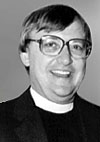
As the parish continued to prosper, a new pipe organ was added, and the front porch was enclosed in glass.
Father White served All Saints' for 25 years.
The Rev. Ronald Davis, in 1979, came at a time when the Renewal Movement was beginning to take hold in the Episcopal Church. All Saints' was not unaffected. Contemporary expressions of worship and healing services attracted many new members. Growth was such that another mission parish, Christ-the-King, was established on the north side of town in 1983. Plans were made for a new education and administration wing to be built. the Rev. Davis moved to Tallahassee in 1988.
The Rev. Dr. Al W. Jenkins, then at St. Margaret's, Inverness, accepted the call as rector June 14, 1989 and started his ministry at All Saints' on July 1st. By 1992, under his leadership, adjacent property was purchased, and the two-story education and administration wing was built along with $500,000 in renovations, debt-free, completing the Anchor of Faith vision of the 1980's.
The chapel was renovated in 1999 and the vision of the 1930's to have stained-glass windows above the main altar was also realized that year.
 Rev. Jenkins has concentrated on building ministries, refining the administration, growing the membership, and financial stability. The parish has many new small fellowship ministries, a new Book & Gift store, and a wide range of educational ministries. One is the Parish Academy, a comprehensive educational ministry for adults that was created in 2003. The other is the Order of St. Luke, a complete pastoral care ministry, built and guided by Rev. Reid Hensarling.
Rev. Jenkins has concentrated on building ministries, refining the administration, growing the membership, and financial stability. The parish has many new small fellowship ministries, a new Book & Gift store, and a wide range of educational ministries. One is the Parish Academy, a comprehensive educational ministry for adults that was created in 2003. The other is the Order of St. Luke, a complete pastoral care ministry, built and guided by Rev. Reid Hensarling.
In 2006 the Westminster Chime project was completed. Four beautiful new bells made in France now hang in the bell tower and are used for a variety of church functions.
In 2012, a new four story building was completed with a new center for youth in grades 6-12, a new Teaching Center, a new worship floor, and a new parish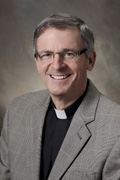 fellowship hall with a beautiful view of downtown Lakeland.
fellowship hall with a beautiful view of downtown Lakeland.
Outreach and mission is prioritized in activities as wide ranging as redevelopment, building for the needy, and sending out teams to mission work when applicable.
In 2014, Rev. Jenkins announced his retirement would be December 31st, 2015, completing 26.5 years, making him the longest serving rector in the parish history. On January 6, 2016, The Rev. Dr. L. Reid Hensarling became the Priest-in-Charge and served in that capacity until November 13, 2016. Fr. Reid began his ministry as rector of All Saints' on November 14, 2016.
As a new age dawns, All Saints' looks back over a century of accomplishments. Consistently blessed with loyal leadership, it has had only one vicar and seven rectors since 1884.
Dedicated clergy and lay leadership have lived the Great Commandment and the Great Commission.
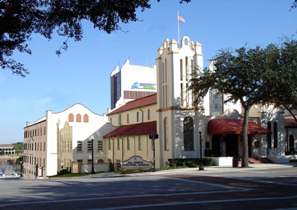 The Episcopal Church in Florida
The Episcopal Church in Florida
The first Convention of the Episcopal Church in Florida was held in Tallahassee on January 17, 1838. At that time there were seven congregations in the entire state. They were: Trinity Church, St. Augustine; Christ Church, Pensacola; St. John’s, Tallahassee; St. Paul’s, Key West; St. John’s, Jacksonville; Christ Church (soon to be renamed “Trinity”), Apalachicola; and St. Joseph’s, St. Joseph. In the absence of a diocesan bishop the Rt. Rev. James H. Otley, Bishop of Tennessee was invited to perform episcopal duties. In 1851 the Rt. Rev. Francis Huger Rutledge was consecrated as the first bishop of the Diocese of Florida and he served until his death in 1866. He was succeeded by the Rt. Rev. John Freeman Young and he was succeeded by the Rt. Rev. Edwin Gardner Weed in 1886.
Somewhat over half a century after the first Convention at St. John’s, the Church had grown enough to be divided into the Diocese of Florida and the Missionary Jurisdiction of Southern Florida. At the time of the division in 1892, there were five parishes, 40 organized missions and 11 mission stations in the new Jurisdiction. Its primary Convention was held on February 21, 1893 at Holy Cross Church in Sanford, presided over by its first Bishop, William Crane Gray. In 1914 the bishop of North Dakota, the Rt. Rev. Cameron Mann, was translated to the Missionary District of Southern Florida.
Despite devastating freezes, a plague, the Spanish-American War, and World War I, the Church continued to grow in Florida. Only a few short years after World War I, there were enough healthy congregations for the Missionary Jurisdiction of Southern Florida to apply for admission as a diocese. In September, 1922, the Diocese of South Florida was formally admitted, and on January 16, 1923, the primary Convention of the new diocese was held at St. Luke's Cathedral in Orlando, with the Bishop Cameron Mann presiding. When Bishop Mann died in 1932 he was succeeded by the Bishop Coadjutor, John Durham Wing who, unlike his two predecessors, was not a born churchman nor was he the son of a clergyman.
During the next four and one half decades, the Church grew rapidly, especially after World War II. In the 1950s alone, 74 new congregations were started in the Diocese of South Florida, and 25 of these had become parishes by 1966. Presiding over much of this growth was Bishop Henry I. Louttit, who assumed the mantle of diocesan in 1950. Bishop Louttit was assisted successively by two able Bishops Suffragan, Martin Bram and William F. Moses. Bishop Moses had been rector of All Saints', Lakeland for 23 years.
At the time the Diocese applied to General Convention for division, there were 204 congregations served by about 250 priests and three bishops. The Special General Convention of 1969 approved the request for the division of South Florida into three dioceses, and in December of that year, Bishop Louttit, Bishop of South Florida presided over the primary Conventions of each new diocese - Southeast Florida, Southwest Florida, and Central Florida - for the purpose of electing their Diocesan Bishops. The two Suffragan Bishops, James L. Duncan (SE) and William L. Hargrave (SW) were elected to be Diocesan Bishops in the areas in which they had been living and serving. Bishop William H. Folwell was elected to succeed Bishop Louttit whose retirement coincided with Bishop Folwell's consecration in Central Florida.
In the early 1970s, that portion of the Diocese of Florida from Apalachicola west became a part of the newly created Central Gulf Coast Diocese, which also includes the southeast half of Alabama. Thus, it has come about that the fledgling Church of 7 congregations of 150 years ago is now comprised within five dioceses.
On December 10, 1988, John W. Howe was elected Bishop Coadjutor of the Diocese of Central Florida and was consecrated April 15, 1989. Bishop Howe became Diocesan Bishop on January 1, 1990. On June 1, 1995, the Rt. Rev. Hugo Pina-Lopez, retired Bishop of Honduras, became Assistant Bishop of the Diocese and then Assisting Bishop on January 1, 2001. A number of other retired bishops have been an invaluable resource to Bishop Howe and the Diocese including the Rt. Rev. Herbert D. Edmondson, retired Bishop of Jamaica; Archbishop Reginald Hollis, retired Metropolitan of the Ecclesiastical Province of Canada and Archbishop of Montreal; the Rt. Rev. John Lewis Said, retired Suffragan Bishop of Southeast Florida; the Rt. Rev. James Adams, retired Bishop of Western Kansas; and the Rt. Rev. Dorsey Henderson, retired Bishop of Upper South Carolina.
At the 31st Convention of the Diocese, held at the Cathedral Church of St. Luke in Orlando (January 29, 2000), the delegates unanimously approved a new vision for the Diocese of Central Florida which called for the revitalization of existing congregations and the establishment of fifteen new congregations in the first ten years of the new millenium. At the 34th Convention of the diocese, held at Trinity Preparatory School in Winter Park (January 25, 2003), the diocese kicked off “From Strength to Strength” - a capital campaign to fund the new vision approved in 2000. This campaign has raised more than $800,000 toward the campaign goal and in addition over $5 million was raised for various congregational campaigns. Between 2004 and 2009, the Diocese welcomed four new missions, expanded Hispanic ministry in two missions and organized Hispanic worshipping communities in several parishes.
2004 was a time of tumult for the diocese with virtually all members of one congregation voting to leave the Diocese and a majority of members of another congregation following suit. At the 35th Annual Convention, the Diocese formally affiliated with the Network of the Anglican Communion Dioceses and Parishes, and affiliation which formally ended five years later. In 2008, members of five congregations and their clergy leaders disaffiliated from the Episcopal Church and thereby from the Diocese of Central Florida; the remaining members of those congregations called clergy in charge and picked up where they had left off, howbeit with diminished resources and numbers. A sixth congregation purchased their existing church property and facilities in 2012. On April 15, 2008 Bishop Howe issued a Pastoral Letter which has become the basis of a new vision for the Diocese.
At the 42nd Annual Convention in 2011, Bishop Howe called for the election of his successor. At a Special Convention held on Saturday, November 19, 2011 at Trinity Preparatory School, Winter Park, The Reverend Canon Gregory Orrin Brewer was elected to be the fourth bishop of the Diocese of Central Florida.
The Diocese of Central Florida is comprised of five deaneries - Central, Northeast, Northwest, Southeast, and Southwest. In January 2012 there are a total of 14 Missions and 73 Parishes.
History of the Diocese of Central Florida
by Beatrice Wilder, Diocesan Historian, April 2008
On the morning of January 5, 1893, Bishop William Crane Gray reached Orlando, the day and place appointed for the meeting of “The Southern Convocation.” The Bishop was fresh from his consecration at the Church of the Advent, Nashville, Tennessee, his former parish. After celebrating the Eucharist at St. Luke’s Church, he presided over the business meeting which set the 2lst of February as the date for organizing the newly formed Missionary Jurisdiction of Southern Florida. That same evening a missionary meeting was held and offerings taken for the mission work of the Jurisdiction.
“This is emphatically a missionary field,” the Bishop declared in his address to the Convocation at the close of his first year. Emphasis on the Church’s mission and on missionaries to 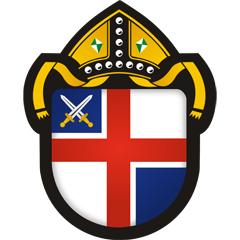 proclaim it, has characterized the Church in Central Florida ever since.
proclaim it, has characterized the Church in Central Florida ever since.
During his first year as Chief Missionary, Bishop Gray reported, “I have traveled between eight and nine thousand miles in traversing my territory…I have confirmed two hundred and thirty-five persons. I cannot tell accurately the number of services, sermons and addresses I have had, but it is somewhere between three hundred and five hundred…However inadequate the results may appear in contrast with the work done, I am hopeful and can truly say, I thank God and take courage.”
“Inadequate” hardly describes Bishop Gray’s efforts during the next two decades. He began his episcopate with 20 clergy; when he retired in 1913 there were 46; the number of communicants had doubled two and a half times from 2,000 to 5,000; he had confirmed 5,000 persons and visited more than 100 places; the number of parishes had increased from five to twelve. The Bishop tendered his resignation at the age of 79 so that a younger and stronger man “with all the force and ability” needed to meet the demands of the future, might continue to forward the work of the Church.
So much had changed during these two decades. “When I first visited Tampa,” said the Bishop, “no one considered the population of the entire environment to be more than 5,000; now it is beyond 60, 000. The railroad extension on the east side has opened stations and multiplied settlements, where my first journeys could find only vast stretches of woods and forests, plains and prairies and miles and miles of coral rock region. Now all these portions have been marvelously changed, and are bristling with life, activity and striking improvement…Men, women and children from distant regions are flocking to this sunny land, and we should be among the first to answer the call, “Come over and help us.” (Acts 16:9  )
)
From the first, Bishop Gray hoped to hasten the day of independence for his jurisdiction and a fund was established for that purpose. But the times were not auspicious. There was a financial “panic” in l893 and the Great Freeze of 189-1895 in Florida, which destroyed the citrus crop as far south as Palm Beach frustrating the Bishop’s efforts. It was left for his successor, Cameron Mann, to accomplish this goal.
An Upstate New Yorker, notable scholar, and former Missionary Bishop of North Dakota, Mann was also an astute financial manager. Just thirty years after the separation from the Diocese of Florida missionary status gave way to the independence of a diocese. Renamed the “Diocese of South Florida”, the First Annual Convention met in St. Luke’s Cathedral, Orlando, on January 16, 1923. The new diocese was destined to be one of the strongest and most unified in the entire South.
Bishop Mann was a prophet for his times, but he speaks to the present also. “I need hardly remind you,” he told the 1925 Diocesan Convention, “that we are living in a feverish and tumultuous world – a world of bewildering physical discoveries and inventions; a world of incalculably increasing material wealth; but also a world of perplexing debates over what used to be deemed axioms; a world of wild political dreams; also a world of suspicions and jealousies and fears…nor do I need do more than barely say that here in South Florida we have peculiar distractions – that there is a roar of business speculations, and a roar equally loud of amusements and sports all around us. It is hard to live ‘a sober, righteous and godly life’ amid all these mundane distractions.” And this was half a century before Disney World, the Magic, and the Daytona 500!
John Durham Wing became our first Bishop Coadjutor in 1925, becoming Diocesan in 1932 upon the death of Bishop Mann. Born in Atlanta, he was well known to many Floridians, especially as a forceful preacher who had been chosen to conduct a missionary campaign in the diocese by the National Church as part of its nationwide program. Therefore, it was natural for him to be entrusted by Bishop Mann with the missionary work of the diocese.
Wing’s 25 years in office were marked by economic extremes, beginning with the Florida boom in 1925 and its collapse a year later. Then came the Great Depression of 1929 to be followed by the remarkable prosperity of the World War II years, when Florida became a strategic area for national defense. Later came the postwar expansion and the outpouring of population and industry into the region. The growth of the diocese more than kept pace with this fantastic influx. The number of communicants soared by 227 percent during Bishop Wing’s tenure. It continued to climb for the next quarter century under his successor, Henry Irving Louttit.
Elected Suffragan in 1945 while still serving as an Army chaplain in the Pacific, Louttit had been ordained deacon, priest, and consecrated bishop by his predecessor. He became Diocesan at the close of 1950 upon the resignation of Bishop Wing. An ardent and energetic missionary, Bishop Louttit was to bring the diocese to unparalleled heights of growth during the next two decades. A new mission was established every six weeks during the first half of his Episcopate, and it became necessary to restructure the diocese, creating three Archdeaneries. The East Coast and the Gulf Coast were each in the care of newly elected Suffragans, while Bishop Louttit retained control of the Central Archdeanery and supervision of the entire diocese.
By the close of the ‘60s the roster of parishes and missions more than topped the 200-mark and continued to climb. The diocese, it appeared, had become too large and unwieldy for effective care and administration. A committee to study division of the diocese was appointed and met for three years. Their conclusion, favoring division, was supported by Diocesan Convention and a petition to create three new dioceses was forwarded to the Special General Convention of the National Church, meeting at South Bend, Indiana, in September, 1969. The petition granted, the newly formed dioceses were structured along the lines of the existing Archdeaneries and organized as the Diocese of Southeast Florida, Southwest Florida, and Central Florida, the latter remaining the continuing diocese. William Hopkins Folwell, Rector of All Saints Church, Winter Park, who had chaired the committee that studied division, became Central Florida’s bishop and was consecrated in February 1970.
The Episcopal Church in Central Florida has never lost sight of its primary purpose, defined in its Constitution, to advance the Kingdom of Christ in the world. Under Bishop Folwell a dozen new missions were established and a number of mission congregations became parishes. The work of evangelism continues under Bishop John Wadsworth Howe, who was consecrated Coadjutor in April 1989 and became diocesan in January 1990 upon his predecessor’s retirement.
At his first Diocesan Convention Bishop Howe called for the development of a Plan for Outreach. Evangelism and Mission that was accepted the following year by the delegates, who further mandated its implementation. The Resolution stated: “In response to the Divine Commission, the call of General Convention, and the Lambeth Conference to a Decade of Evangelism, we the people of the Diocese of Central Florida do solemnly endeavor to present the Gospel of Jesus Christ in the power of the Holy Spirit in such ways that persons may be led to believe in Him as Savior, and follow Him as Lord in the fellowship of His Church.”
Among the priorities set were the establishment of new mission churches to minister to the growing population; doubling our membership; and increasing our congregations by 15 more churches by the end of the decade.
The past hundred years have witnessed the evolution of Florida from a rural to an urban culture. The fourth largest state in population, edging out New York to become the third, it has nine of the nation’s fastest growing metropolitan areas, five of them in the Diocese of Central Florida. A century ago there were a little over 2,000 communicants in the vast Jurisdiction stretching from Ocala to Key West. Now there are close to 30,000 in one-third of that area.
The field is ripe for harvest. William Crane Gray, our first bishop, said, “Take courage.” Our present bishop, John Wadsworth Howe, says, “Let’s get on with it."
